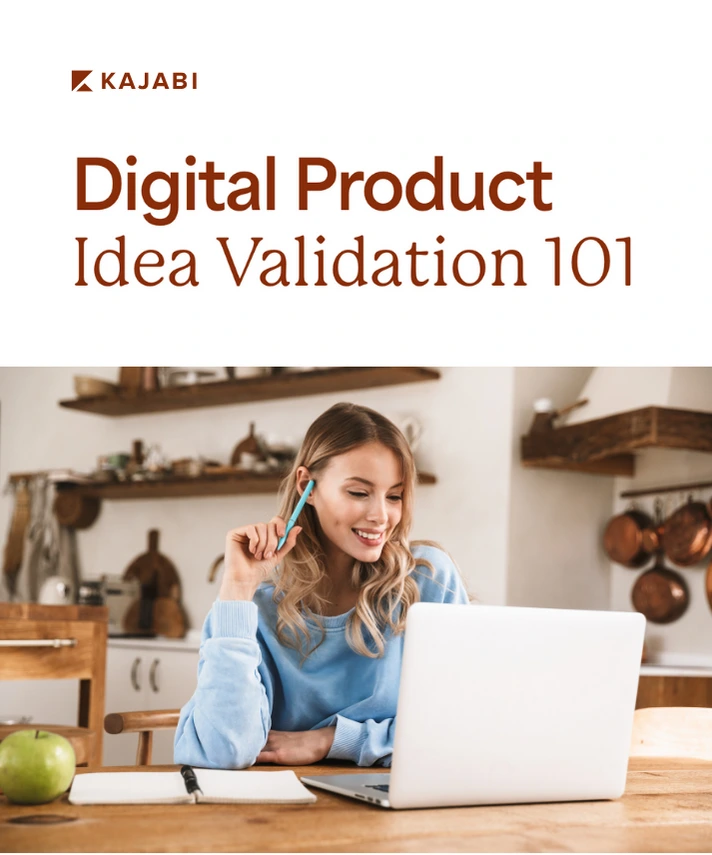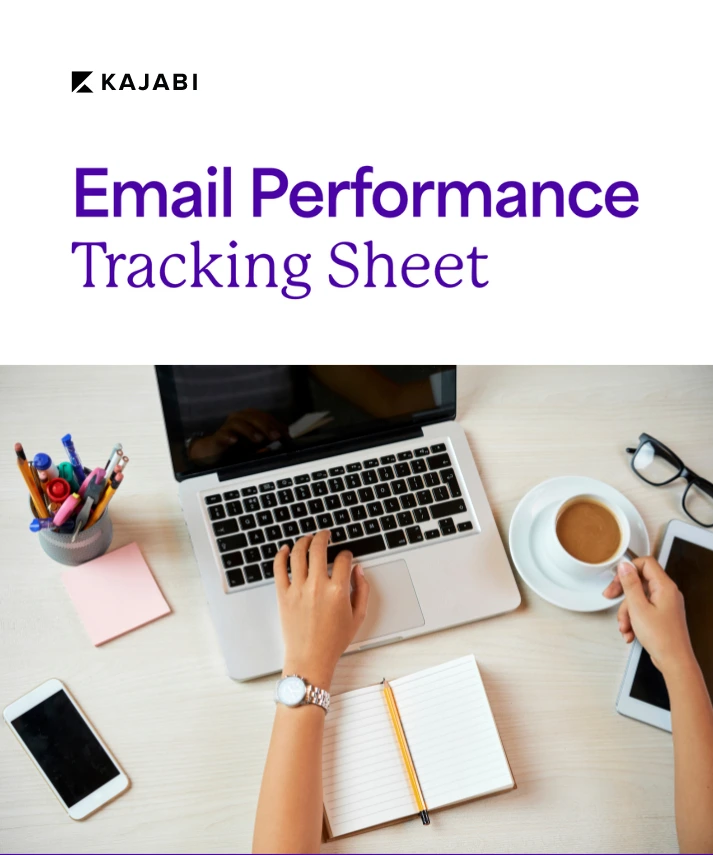
What Is Opt-In Email Marketing: Definition, Example, and Template
Get free expert insights and tips to grow your knowledge business sent right to your inbox.
When you visit your mailbox every day, do you carry a stack of unsolicited flyers, postcards, circulars, and other advertisements?
That’s called outbound marketing. It’s a spray-and-pray approach that marketers use to spread their messages as far and wide as possible. They know that most of their ads wind up in the recycling bin.
Opt-in email is a completely different form of marketing. It’s an inbound approach that Seth Godin termed “permission marketing.” In other words, you’re getting your prospect’s permission to receive communications from your brand.
Why is that important?
Because your prospects are far less likely to send your messages to the virtual equivalent of the recycling bin. They’ve given you their email addresses for the express purpose of receiving content from you.
Opt-in email isn’t just more effective. It’s also more ethical. Cluttering up email inboxes with unsolicited messages is a surefire way to ruin your brand image and reputation. People just don’t respond well to it, especially since 269 billion emails get sent every single day.
You don’t want to be part of the noise. You want to connect with your customers and convince them to sign up for your online courses.
Opt-In Email Definition

Opt-in email is defined as an email that a brand sends after a consumer willingly provides his or her email address. Brands can collect email addresses in myriad ways, but usually they use forms on their websites as well as incentives, such as free downloads.
Think of it as a way to authenticate your email list. Instead of sending emails blindly to people who might not have any interest in your online courses, you’re spending time only on people who already know who you are and who want to hear from you.
What Is Opt-In Email Marketing?
Opt-in email marketing is a marketing campaign that uses permission-based email-collection methods to capture email addresses from willing consumers. Once you have a potential customer’s email, you can add it to a marketing list based on the customer’s position in the sales funnel.
For instance, if your prospect signs up for your email list during his or her first interaction with your brand, you might segment that consumer into a list that introduces your online courses and provides actionable tips for interested consumers.
However, if your prospect joins after buying a course, you could send emails about getting the most out of your course material or about applying the information you teach to the real world.
Opt-in email marketing isn’t just a way to capture email addresses so you can blast prospects with sales copy. In fact, that’s the worst way to use it.
Instead, use opt-in email marketing to nurture your prospects through the sales process.
- Invite prospects to interact: Let your email marketing recipients know where to find you online, from your social media accounts to your blog.
- Encourage customers to convert: Provide sound reasons why a prospect should buy one of your courses. Use real-world examples to illustrate your points whenever possible.
- Follow up with prospects: If a prospect abandons his or her shopping cart or goes inactive for a while, reconnect with a nurturing email that reminds him or her that you exist.
- Send promotions: Offer discounts and other promotions that encourage prospects to buy your course for the first time or to buy a subsequent course.
Set up your opt-in email marketing campaign based on your specific objectives. Every course creator has different goals, so you don’t want to copy someone else’s campaign. Instead, think of the goals you want to reach, then design emails that help push customers to help you reach them.
- Gain brand visibility: If you want to establish yourself as an authority figure in your industry and make more people aware of your brand, encourage your email opt-ins to share your messages. The more people forward your emails, the more signups you get.
- Boost sales: Use promotions, bundles, and discounts to get people to finally hit the “buy” button.
- Increase upsells: Encourage customers to buy multiple courses and other digital products.
- Check on progress: Find out where your customers are in their online courses and whether they need any assistance or have any feedback.
- Solicit reviews: Ask your customers to review your courses online. You’ll get backlinks as well as more brand visibility. Plus, prospective customers will feel more comfortable buying from you. In fact, nearly 85 percent of respondents to a study stated that they trusted online reviews as much as they valued recommendations from friends.
You’ll continually adjust your email marketing campaign as you gain more subscribers and measure the results. Even though you’re using an opt-in email approach, you can’t always predict whether customers will open, read, or engage with your emails.
Keeping track of key metrics can help.
- Open rates: If customers don’t open your emails, you might need to create more compelling subject lines or introduce an incentive early in your emails.
- Engagement rates: Customers open your emails, but they don’t do anything else. If this happens, add more attractive calls to action using freebies and discount codes. Get people to click on links through incentives.
- Conversion rates: Do customers buy your online courses after reading your emails? You can track conversions through email and landing pages to figure out how well you’re converting.
If you’re struggling to gain traction with your email marketing campaign, you might need a stronger lead magnet.
For instance, let’s say that you design online courses for fitness buffs. You could create a lead magnet like a PDF filled with illustrated exercises and pro tips. Other options could include video demonstrations of exercises or a free checklist for people who are interested in HIIT.
Spam Versus Opt-In Email
Spam is an ugly word, right? You don’t want people to associate it with your brand.
Unfortunately, even when you use opt-in email, your emails could be perceived as spam. It happens when you use overly promotional, salesy language, or when you send too many emails in too short a time period.
Additionally, if you don’t use the opt-in strategy at all, you risk your emails getting diverted to spam folders. If your recipients report your emails as spam, their email clients might automatically assume that everything you send is spam. That’s the wrong way to start an email marketing campaign.
So what differentiates spam from opt-in emails?
First, of course, is the permission factor. When you collected an email address, did you get permission from the person who owns it? In other words, did it come via a form or other email-collection tool? If not, you might not want to use it.
Secondly, were you clear about the types of messages the consumer would receive?
It’s easy to collect email addresses via a form if you promise rainbows and unicorns. Unless you can actually deliver rainbows and unicorns, however, you’re being disingenuous, and your subscribers will quickly catch on to your game.
When you collect email addresses through an opt-in form, make two things perfectly clear:
- Email type: What messages will the subscriber receive? Mention that you send insider tips and tricks, promotions and sales, or other content (but make sure it’s true).
- Frequency: How often should subscribers expect to hear from you? If you promise to email only once per month, but you send emails every day, you’ll get some backlash.
If you follow those rules, you can separate your email campaign from the dreaded spam word.
Keep in mind that black-hat email marketing techniques will automatically classify your messages as spam. For instance, don’t ever buy an email list. It’s an ineffective marketing technique, for one, but it’s also unethical and spammy.
Additionally, don’t break your own rules. If you decide to change the types or frequency of emails you send, let your subscribers know so that they can opt out if they wish.
There’s another factor that helps define spam.
Let’s say that you do some research on LinkedIn to find people who might be interested in your course on leadership. You find a few people who seem like great leads, so you send them InMail or an email message to introduce yourself and your online courses.
The recipient didn’t opt in to receive your email, but it’s not spam. Why? Because you sent a single email to a single individual.
For emails to qualify as spam, they must be sent in bulk. In other words, you send out a mass email to a bunch of email addresses at the same time. You don’t personalize any of the messages.
When you send single emails to people who might be interested in your digital products, and when you personalize those emails based on what you know about the recipients, you’re simply sending cold emails. It’s not the fastest way to boost conversions, but it’s not shady, either.
What Is Opt-Out Email?

Opt-out email is a marketing strategy that allows consumers to opt out of email campaigns that no longer interest them. It sounds like a bad thing, but opt-out email isn’t necessarily negative. In fact, it can make your email campaign stronger.
There are two main points at which you can give your subscribers the opportunity to opt out of emails from your brand:
When Signing Up for Something Else
Let’s say that you collect email addresses from people who want to download a free white paper or who buy another digital product from you, such as an ebook. Many entrepreneurs use this opportunity to add those emails to their email marketing lists.
It’s not a bad strategy, but it can backfire.
Maybe the consumer wanted the free white paper or the ebook, but does not want to receive sales emails. That’s understandable. You can include an option to opt out of your email list right then so you don’t have to worry about upsetting people or getting your emails flagged as spam.
When Sending Emails
Every email you send should include an “unsubscribe” option at the end. If a user clicks on that button, he or she can opt out from receiving future emails from you.
While it might sting a bit, it’s better than having your emails consistently flagged as spam. Consumers know what they want to read, and if they’re not interested in your messages, you’re better off letting users unsubscribe.
You don’t want users to opt out from your email list, but it happens to every entrepreneur. Your message will resonate with some consumers, but others won’t respond as positively. That’s okay. Just focus on nurturing the subscribers who continue to open and engage with your emails.
Opt-In Email Templates and Examples
Now you’re ready to capture email addresses from potential subscribers. You’ll need an opt-in email template that allows you to collect those addresses effectively on your website, blog, or other web assets.
A simple form that you put in your sidebar or at the top of your page can work well. However, you have several other options, as well, depending on your website’s setup and the email service you use to send marketing emails.
Popups
Many entrepreneurs use pop-ups on their websites to collect email addresses. A pop-up is a window that appears over your usual website content. It invites the user to sign up for your email marketing campaign and often includes an incentive.

As you can see, SocialTriggers.com uses a pop-up to collect email addresses. It’s triggered when the user attempts to exit the page. You can also set email pop-ups to appear after a user spends a certain amount of time on a page or when the user visits more than one page on your website.
Below Your Products
The area just beneath the products you list on your home page or sales page can also include an email signup form.

Nike uses this tactic on its homepage. After you scroll past several sneakers and other shoes, you see this invitation. Users can click on the “signup” link at the bottom, provide their email addresses, and receive special promotions from Nike.
You’ll notice that Nike uses the best practices we mentioned above. The company lets users know exactly what type of content they can expect to receive after they sign up.
You can put your email template on just about any page of your website or blog. Consider adding them to social media, as well, so you can capture your audience there.
Building a Template
Once you decide where you want to put your email template, you must design the template itself. It should include a combination of buttons, graphics, and text that encourage the user to opt in.
- Create a headline. You can use something simple like Nike’s “Sign Up for Nike Email” or try something a little more creative. Make sure your headline aligns with your brand’s message and your course content. You can also create a graphic headline that attracts attention.
- Describer the perks. Tell users exactly what they can expect to get in exchange for providing their email addresses. You can offer an incentive, such as a free download, as well as mention coupon codes and any other promotions you might send their way.
- Add a button. Buttons make it obvious that you want the user to click. You can either include the button in your email template or put it at the end of your form, depending on how you’ve designed it.
- Collect the information. Keep in mind that most people won’t fill out detailed questionnaires just to get a free white paper. Asking for the person’s name and email address should prove sufficient.
The design is completely up to you. Add lots of color and images if that aligns with your brand, or keep it simple and subdued.
Keep in mind, however, that consumers will pay more attention if your email opt-in template stands out. Consider using a bright color for your background or formatting the text in bold or a different color.
You can also A/B test your email forms. Try two different forms on separate pages to see which one converts the best. You can run multiple tests over several weeks or months to figure out exactly which strategy will work best for your prospects.
Forms
Several different types of email opt-in forms exist, each of which produces a slightly different result. Choose the form type that feels most comfortable for you.
Unconfirmed Opt-In
Also called a “single opt-in,” this type of form collects the email address immediately when the user fills out the form. The address gets added to the email marketing database, and the user will receive emails from that point forward.
It’s the easiest type of form to use, and it often results in a larger list. However, if a user forgets about filling out your form, he or she might view future emails as spam. You can take that risk, but you might want to consider one of the other form types if you want to keep your email list as clean as possible.
Confirmed Opt-In
This type of form is also called a “double opt-in” because it requires two steps. First, the user provides his or her email address and other information in the form. Afterward, he or she receives an email confirmation.
The email doesn’t get added to the entrepreneur’s database until the user clicks on that link. In other words, each subscriber has two opportunities to opt out from the list. If someone accidentally fills in your form or has second thoughts, there’s no harm done.
Email Address Authentication
A form that includes email address authentication helps guard against incorrect information. You’ve made mistakes while typing your email address, phone number, and other information before, so your subscribers might make the same mistake.
After users fill out your email opt-in form, they will see a page that urges them to check their email. It will also invite them to fill out the form again if they don’t receive a confirmation via email. You won’t miss out on potential subscribers due to inaccurate information, and your subscribers will be more likely to remember signing up for your list.
Advantages of Opt-In Email

Once you create an opt-in email campaign, you’ll gain access to several advantages that can help you market your online course more effectively.
- Streamline your marketing approach. Create drip email campaigns that help you nurture your leads gradually toward a sale and that keep them engaged with your business.
- Gain access to interested prospects. An opt-in program ensures that everyone who lands in your email database wants to receive messages from you. You’re not wasting anyone’s time, and you know you’re marketing to the right people.
- Automate your marketing campaign. You can schedule emails to get delivered at regular intervals, and you can write emails in advance, then schedule them for distribution later. You’ll save time that you can use to create more online courses.
- Avoid getting classified as spam. Once email clients perceive your messages as spam, you’ll struggle to get your emails seen, let alone read.
- Segment your audience. Add emails to different lists based on the behaviors or activities that triggered the opt in, such as signing up to receive a free download or buying one of your other digital products.
- Build a following. Your audience matters when you want to make money with online courses. Your email audience can easily extend over into social media and your blog if you promote those assets in your emails.
- Educate your audience. People love to learn. Consider creating an email course that whets your audience’s appetite for paid courses down the road.
The Rise of Implicit Opt-In

Implicit opt-in has become increasingly popular in the marketing space. It’s defined as an opt-in email form that that’s unrelated to the email marketing campaign, but that automatically adds the user to the database.
Let’s say that you sell fine-art photography and you’ve created an online course for beginning photographers. Someone buys a photo from you, and during the process, you add the email address to your marketing database.
You’ll include language in the form or your privacy policy that lets the user know that downloading the product gives his or her implicit consent to receive marketing emails. There isn’t a direct correlation between your email marketing campaign for your photography online course, but the user will begin to receive marketing emails.
It’s a good strategy for quickly building a huge database of emails, but it’s also a little risky.
For one thing, some people don’t appreciate implicit opt-in. They’ll forget that they were included in your email database, and they might get angry when they start to receive promotional emails from you.
The risk increases when the initial opt-in doesn’t have much to do with the email marketing campaign. For instance, someone who buys a fine-art photograph might not want to learn photography. They simply want to appreciate it.
You can use implicit opt-in, but make the outcome as obvious as possible.
Best Practices for Gathering Permission-Based Email Subscriptions
Now that you’re ready to collect email addresses using a permission-based opt-in program, use these tips to increase engagement and improve the outcome of your efforts.
- Add your email opt-in form to every page on your website and blog. You want as many people as possible to see it.
- Segment your audience based on their behavior. For instance, someone who has never interacted with your business before doesn’t belong on the same list as a person who has bought one of your courses in the past.
- Use double authentication and other strategies if you want to build the strongest list possible. When you narrow down your list to the people who truly want to be there, you’ll build an audience of highly engaged, ready-to-convert leads.
- Mix up your email content. One week, for instance, you might send a coupon code for a discount on your courses. The next week, send an educational email that teaches your subscribers how to solve a problem or reach a goal.
- Track your metrics. Pay careful attention to open rates, engagement rates, bounce rates, and other metrics that might inform future efforts.
- Invite subscribers to share your emails. Ask them to forward them to interested family and friends. Those people might become direct subscribers.
- Never forget a call to action. You want each email to drive your subscribers toward a specific next step, such as buying your course.
Conclusion

Every business needs an effective opt-in email strategy. It’s the single easiest way to keep in touch with your prospects.
After all, you don’t create online courses just to watch them sit, unseen, on your sales page. You want people to buy, complete, and enjoy your courses.
Email gives you direct line to each prospective customer. Plus, it keeps you engaged with customers who have bought from you in the past, and therefore might buy from you again.
Plus, if you use the best practices described above, you’ll encourage your customers to spread your message and to engage with you elsewhere online.
Of course, you have to create an email program first. Once you’re ready to go, start collecting emails and sending messages.
You’ll thank yourself when your online courses start flying off their virtual shelves.
Create Your First Online Course On Kajabi
Sign Up For A 14-Day Free Trial Today













